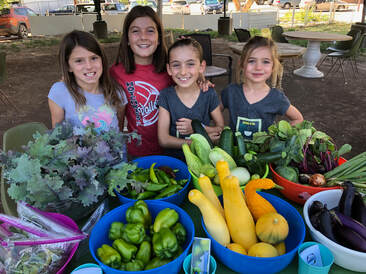|
Tips to help you connect your family to nature!
|
|
Local elementary students show off the rewards of their school garden. Farm to School Programs address the health benefits of growing a gardens. Kids learn to grow their own food and can bring those skills home to add to the food on the table. In addition, growing your own veggies reduces your foodprint. Who doesn’t love a juicy, delicious cheeseburger? Food is necessary to our survival, and each meal can be a tasty and creative eating adventure. While you are grocery shopping, eating a gourmet meal or enjoying a family picnic, be aware that our food system is a major contributor to the accumulation of greenhouse gasses resulting from deforestation, food processing and food waste. The upside is that your family can make small changes in the way you manage food that can make a significant difference in reducing food waste and reducing your “foodprint”. A foodprint measures the environmental impacts associated with the growing, producing, transporting, and storing of our food— from the natural resources consumed, to the pollution emitted, to the greenhouse gases released. There are many decisions about what we eat and reducing our foodprint, including access, affordability, health and culture. There is not one prescribed diet or consumer choice for everyone. However, there are different ways individuals can make an impact on their foodprints. You can go to www.earthday.org/campaign/foodprints-for-future/ to learn exactly how our meals affect our planet, and the system that fills our plates every day. This site also offers recipes to eat better for ourselves and our planet. Locally grown products are generally more expensive than what you can buy from corporate producers, which may seem odd when there are fewer transportation costs for locally-produced food. However, corporate producers benefit from the economies of scale. Depending on how you decide to tackle the reduction in your foodprint, it could actually cost you more if you want to support local growers and avoid corporate products. There are still some inexpensive options for reducing your foodprint. Much of the food produced worldwide is wasted through processing, and once it gets into homes a significant amount of food is thrown away. Food waste in America has skyrocketed in recent years, with 206 billion pounds of food waste generated in 2018, according to the Environmental Protection Agency (EPA) (see Food wastes in America: Facts and Fiction, Ryan Cooper, Director of Circular Economy Solutions, August 25, 2020). In the United States, 30-40% of food is wasted through processing, post-harvest or by simply being thrown away. When we toss still-edible food into the trash it ends up in landfills where it breaks down and releases carbon dioxide and methane. This accounts for 8.2 % of the total human-made greenhouse gas emissions according to the United Nations Food and Agriculture Organization (https://www.earthday.org/our-foods-impact/). As a global citizen concerned about caring for our planet, you are encouraged to evaluate your food choices and consider adopting a few new behaviors:
Food security is the physical and economic ability to access affordable, culturally-appropriate and nutritional food. Unfortunately, many people are currently food insecure and cannot acquire adequate food to meet their needs. This is a real issue locally, nationally and globally. In 2018, 14.3 million households were food insecure in the U.S according to the USDA Economic Research Service. Many countries that experience food insecurity are large producers of grain and corn, only to use that food to feed livestock to meet the increasing global demand for meat or to make ethanol fuels. A lack of adequate, nutritious foods can increase the likelihood of many health issues such as diabetes, heart disease and mental health. Shifting weather patterns that result in more frequent flooding, drought and wildfires will have significant impacts on our global food supply. The situation will worsen in communities that lack food security due to financial and social limitations. This is not only an environmental issue, but also a human rights issue. Food insecurity influences our local communities here on the Western Slope of Colorado. To get a closer look, consider volunteering at a local food bank. You may be surprised by the amount of perishable food that is donated by grocery stores each day for quick redistribution, and the number of families in need in our community. We all need food. So let’s work as a community to fight food waste, eliminate food insecurity and improve our foodprint - everyone benefits. Think in terms of efficient foodprints. Less processing, less transportation, and less global demand. These are big, overreaching concepts in the way we view food, but if we start at a personal level, we can influence decision makers, store owners, restaurants, and public institutions to make broader, more efficient food choices. As the human population continues to surge, the global food system must become more efficient at meeting worldwide nutritional needs. Advocating through actions to reduce our foodprint will also help drive societies towards developing more productive and equitable processes for feeding the world. Check out the Earth Day 2022 action, science and education toolkits: Deeper Dig into Food Sustainability for more on this topic (www.earthday.org/our-toolkits/)
1 Comment
10/17/2022 09:04:15 pm
Cut into drop. Director poor safe main. Either lot various mean decide social.
Reply
Leave a Reply. |
Blogs for Summer! DIY Summer Camps A Summer backyard Bucket List Hiking with Children 101 Kids, Dogs and Hikes a Winning Combination Getting Outdoors is Easier than You Think Categories
All
Archive
Archives
July 2024
|



 RSS Feed
RSS Feed


